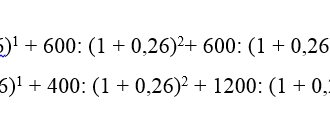What is the cash flow of a project?
Ultimately, the investor is interested in the effectiveness of the project. But it directly depends on the time during which the assessment will be carried out.
Thus, the effectiveness of the investment project is assessed during the calculation period, covering the time interval from the start of the project to its termination.
It is this calculation period that is called the calculation horizon.
The billing period is divided into steps - segments, within which the data used to evaluate financial indicators is aggregated.
Consequently, the calculation steps can be taken as: years, quarters, months, etc.
However, it is necessary to understand that the smaller the step, the more, on the one hand, the more accurate the calculations will be, and, on the other hand, an increase in the number of periods will lead to an increase in the complexity of the calculations, and therefore to an increase in financial costs.
The cash flow of an investment project is the time dependence of cash receipts and payments during the implementation of the investment project, determined for the entire billing period (at each calculation step).
At each step, the cash flow value is characterized by:
- an inflow equal to the amount of cash receipts at this step;
- outflow equal to payments at this step;
- balance (active balance, effect) equal to the difference between inflow and outflow.
Criteria for assessing cash flow
Users of information about cash flows can be the owners of a business entity, investors, and groups of creditors. Criteria for assessing estimated values for cash flows:
- If the NFC value is above zero, the investment project is considered effective and worthy of attention.
- Net cash flows are zero - it is recommended to reject the project due to the lack of prospects for increasing its value.
- When comparing several investment projects to choose the area of investment, you need to focus on the area of activity for which the net cash flow indicator is higher.
Types of flows (Cash Flow)
Cash flows from operating activities are flows resulting from those transactions that are not transactions in the investing or financing activities of the company. Operating activities include all core activities of the company .
Cash flows from financial activities - receipts and payments of funds associated with attracting additional share capital or share capital, obtaining long-term and short-term loans and borrowings, payment in cash of dividends and interest on deposits of owners and some other cash flows associated with the implementation of external financing economic activity of the enterprise.
Cash flows from investing activities - flows from an enterprise investing funds in financial assets and fixed assets (buildings, structures and equipment) or selling such assets
The total cash flow consists of flows from individual types of activities: operating, financial, investment.
Therefore, the flow formula will look like this:
Thus, in order to determine the cash flow of an enterprise as a whole or the flow from a specific project , it is necessary to add up the flows from 3 types of activities: operating, investment and financial.
Examples of positive and negative flows from various activities
Cash flow from operating activities
This type of flow is formed as a result of the core activities of the enterprise.
Operating expenses are:
- expenses associated with the lease of assets;
- expenses associated with the sale, disposal and other write-off of fixed assets and other assets;
- interest on loans and borrowings;
- expenses for payment of services of credit institutions;
- contributions to reserves.
| Indicator name | step 0 | step 1 | … | step T |
| 1. Sales volume | ||||
| 2. Price | ||||
| 3. Sales revenue (item 1 * item 2) | ||||
| 4. Non-operating income/expenses | ||||
| 5. Variable costs | ||||
| 6. Fixed costs | ||||
| 7. Depreciation | ||||
| 8. Interest on loans | ||||
| 9. Profit before taxes | ||||
| 10. Taxes and fees (depending on the taxation system) | ||||
| 11.Net operating income | ||||
| 12. Depreciation | ||||
| 13. Net cash flow from operating activities (item 11 + item 12) |
Cash flow from financing activities
Financial flow is directly related to the financial activities of the enterprise , within the framework of which financial resources are attracted to implement the investment project.
These resources can be own , when the investor contributes his assets, or borrowed . Borrowed resources can be, for example, bank loans or loans.
Accordingly, if the business was opened with borrowed funds, then repayment of the loan body will be reflected in the financial flow.
However, it should be noted that interest on the loan relates to operating activities.
| Indicator name | step 0 | step 1 | … | step T |
| 1. Own capital | ||||
| 2. Short-term loans | ||||
| 3. Long-term loans | ||||
| 4. Repayment of loan debts | ||||
| 5. Payment of dividends | ||||
| 6. Net cash flow from financial activities (clause 1 + clause 2 + clause 3 - clause 4 - clause 5) |
Cash flow from investing activities
This type of flow is closely related to the pre-investment, investment and liquidation stages of the project.
Negative cash flow reflects the costs of starting a project. While the positive flow is due to the sale of remaining equipment, a reduction in working capital, etc.
| Indicator name | step 0 | step 1 | … | step T |
| 1. Purchase of fixed assets | ||||
| 2. Replenishment of working capital | ||||
| 3. Sale of old equipment | ||||
| 4. Reducing working capital | ||||
| 5. Net cash flow from investment activities (clause 3 + clause 4 - clause 1 - clause 2) |
Calculation of cash flow. Part. 2: Net and free cash flow.
In this article, we will look at what net cash flow (NCF) and free cash flow (FCF) are, as well as how to calculate the subtypes of free cash flow: FCFF and FCFE.
Net cash flow
Net cash flow is designated as NCF (eng. Net cash flow ), which is defined as the sum of all positive and negative transactions from the company's investing, financial and operating activities.
The formula for net cash flow is as follows:
NCF = CFO + CFF + CFI,
Where
CFO – cash flow from operating activities,
CFF – cash flow from financing activities,
CFI – cash flow from investment activities.
We wrote in detail about what CFO, CFF and CFI are and how they are calculated in the first part of this article .
A simplified scheme for calculating cash flows from the implementation of an investment project:
Thus, the cash flow of the project can be simplified by the following algorithm:
- Investments;
- Revenue growth;
- Increase/decrease in operating expenses (without depreciation);
- Changes in depreciation charges;
- Change in income before tax (clause 2 – clause 3 – clause 4);
- Change in income tax (item 5 * 20%);
- Change in net profit (clause 5 – clause 6);
- Changes in depreciation charges;
- Net income from the implementation of the investment project (cash flow from operating activities) (item 7+item 8).
It should be noted that it is the change in indicators that appears in the algorithm. This is due to the fact that only indicators for the new project should be taken into account.
For example : If you decide to open another direction within an existing business, then investments, revenue, current costs, etc., must be taken only for this new business.
That is, if you, for example, had a confectionery shop that produced cakes, and you decided to launch a line for the production of cakes, then both revenue and costs to assess the effectiveness of the project must be taken in this direction.
This is understandable, because the company already received revenue from the sale of the cake. From a business point of view, the effectiveness of the new project is interesting.
Classic Free Cash Flow Formula
Typically, FCF is calculated as net cash flow from operating activities minus capital expenditures.
The most popular formula is simple: we subtract the costs of maintaining the company from earnings. The result is an amount that can be taken out of the business without breaking it. To make it more realistic, the costs of loans, taxes and pension payments are included in the formula. Otherwise, it turns out that the formula does not reflect absolutely free cash flow, because paper profit and cash are two different figures.
Some borrowed funds or profits exist only on paper, but in reality they are spent so quickly that the business cannot manage them.
Here is a list of the most popular FCF formulas:
- FCF = Net cash flows from operating activities - capital expenditures (Capex);
- FCF = EBITDA - income tax paid - capital costs (Capex) - changes in working capital (NWC, Net working capital change);
- FCF = EBIT*(1-tax) + depreciation - capital costs - changes in working capital.
As you can see, just subtract anything else from the cash flow, and you get a new formula. And when you choose whether to use old or new data, you get even more formulas. But you don’t have to calculate it all yourself - there is information on the Internet on the FCF of almost all companies in Russia and abroad.
FCF has two types: FCF E and FCF F. FCFF shows funds available only to the company, but the interests of creditors are not taken into account in the formula. But FCFE is a cash flow available to creditors, the company, and you and me, investors. Therefore, the second indicator is more important for us.
An example of calculating net cash flow and net income of an investment project
Knowing that the cumulative cash flow consists of flows from three types of activities, you can easily calculate it using an example.
At the same time, it is necessary to understand that a business project will not be able to function in conditions of a negative cumulative flow, since cash gaps will arise. Therefore, if at some step a negative accumulated cash flow is predicted, then additional financing must be attracted to the project.
What is net cash flow
Net cash flow
Net cash flow
(eng.
net cash flow
) is the difference between positive and negative cash flow, i.e. between the receipt of funds by the company and the necessary expenses. Net cash flow is one of the most important indicators, as it reflects the level of well-being of the company and determines investor interest in it.
Net cash flow allows investors to determine how profitable an investment in a particular company is:
- If cash flow is above zero, then we can talk about investment attractiveness;
- If cash flow is below zero or equal to it, investments in this company are considered high-risk.
??
Accordingly, the higher the cash flow indicator, the more investment attractive the company is considered.
The net cash flow of any company is formed from the following main activities:
- Operating
- funds received or used in the main activities of the company. Positive cash flow consists of money received from sales of goods or provision of services, advances from customers; negative - employee remuneration, cost of goods, taxes. - Investment
- funds associated with previously made investments. The inflow is due to income from the sale of intangible assets, and the outflow is due to the acquisition of investment objects and the expansion of the company's investment activities. - Financial
means funds intended to expand operating and investment activities. The inflow of money occurs through the receipt of loans and credits and the issue of securities, the outflow through the repayment of loans and borrowings, and the payment of dividends.
Discounting cash flows: what and why...
However, due to the fact that investment projects are often quite lengthy, they cannot but be subject to inflation.
Inflation is inherent in any country and affects the depreciation of the money supply. Consequently, cash flows are also depreciated due to inflation. And with 1000 rubles in 5 years, the investor will be able to buy much fewer goods.
Therefore, for a more accurate assessment of the effectiveness of investments, taking into account the time factor, it is customary to discount the project flows. To do this, you need to use a discount rate (rate of return).
In particular, by determining such indicators as: net present flow (NPV, NPV) , discounted payback period (Current, DPB), discounted profitability index (ID, DPI) , etc. or net income (NH, NV) , payback period (Current, PB), profitability index (ID, PI) , etc.









